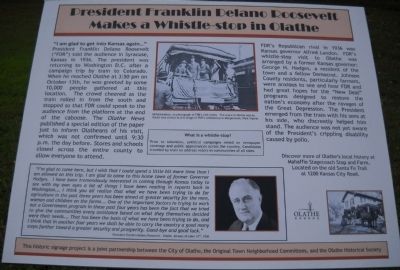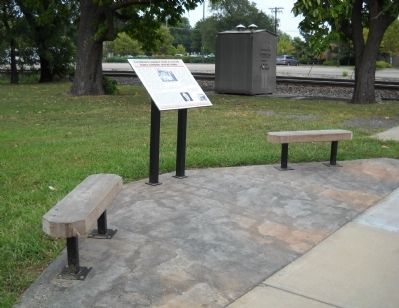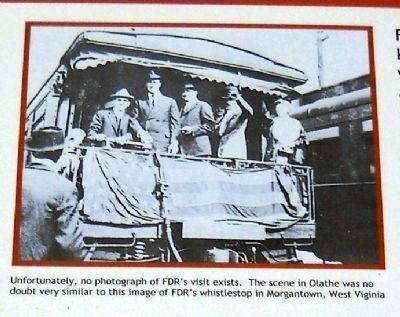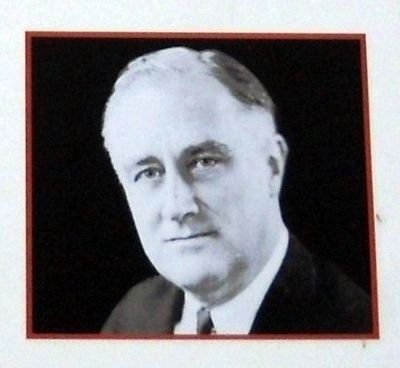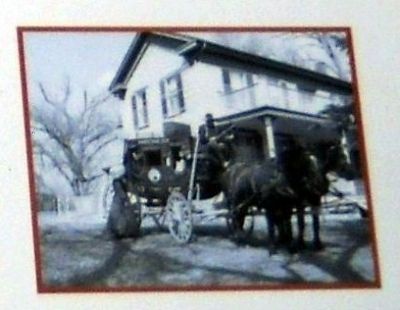Olathe in Johnson County, Kansas — The American Midwest (Upper Plains)
President Franklin Delano Roosevelt Makes a Whistle-stop in Olathe
Inscription.
"I am glad to get into Kansas again..."
President Franklin Delano Roosevelt ("FDR") told the audience in Syracuse, Kansas in 1936. The president was returning to Washington, D.C. after a campaign trip by train to Colorado. When he reached Olathe at 3:50pm on October 13th, he was greeted by some 10,000 people gathered at this location. The crowd cheered as the train rolled in from the south and stopped so that FDR could speak to the audience from the platform at the end of the caboose. The Olathe News published a special edition of the paper just to inform Olatheans of his visit, which was not confirmed until 9:30 p.m. the day before. Stores and schools closed across the entire county to allow everyone to attend.
FDR's Republican rival in 1936 was Kansas governor Alfred Landon. FDR's whistle-stop visit to Olathe was arranged by a former Kansas governor; George H. Hodges, a resident of the town and a fellow Democrat. Johnson County residents, particularly farmers, were anxious to see and hear FDR and had great hopes for the "New Deal" programs designed to restore the nation's economy after the ravages of the Great Depression. The President emerged from the train with his sons at his side, who discreetly helped him stand. The audience was not yet aware of the President's crippling disability caused by polio.
What is a whistle-stop? Prior to television, political campaigns relied on newspaper coverage and public appearances across the country. Candidates traveled by train to address voters in communities of all sizes.
"I'm glad to come here, but I wish that I could spend a little more time than I am allowed on this trip. I am glad to come to this home town of former Governor Hodges. I have been tremendously interested in coming through Kansas today to see with my own eyes a lot of things I have been reading in reports back in Washington... I think you all realize that what we have been trying to do for agriculture in the past three years has been aimed at greater security for the men, women and children on the farms... One of the important factors in trying to work out a Government program in these past four years has been the fact that we tried to give the communities every assistance based on what they themselves decided were their needs... That has been the basis of what we have been trying to do, and I think that in another four years we shall be able to carry the country a good many steps farther toward a greater security and prosperity. Good-bye and good luck."
President Franklin Delano Roosevelt - Olathe, Kansas; October 13th. 1936.
Erected by City of Olathe, Original Town Neighborhood Committees,and Olathe Historical Society
.
Topics and series. This historical marker is listed in these topic lists: Communications • Railroads & Streetcars. In addition, it is included in the Former U.S. Presidents: #32 Franklin D. Roosevelt series list. A significant historical year for this entry is 1936.
Location. 38° 53.023′ N, 94° 49.339′ W. Marker is in Olathe, Kansas, in Johnson County. Marker is on Santa Fe Street, 0.1 miles west of Kansas Avenue, on the right when traveling west. Touch for map. Marker is in this post office area: Olathe KS 66061, United States of America. Touch for directions.
Other nearby markers. At least 8 other markers are within walking distance of this marker. Home For Christmas (about 700 feet away, measured in a direct line); Bicentennial Time Capsule (about 700 feet away); R.R. Osborne Plaza (approx. 0.2 miles away); Children of the Trails (approx. 0.2 miles away); Santa Fe Trail (approx. 0.2 miles away); Olathe World War Memorial (approx. 0.8 miles away); Olathe Civil War Memorial (approx. 0.8 miles away); Elvira Beckwith (approx. 0.9 miles away). Touch for a list and map of all markers in Olathe.
More about this marker. This marker is on the north side of Santa Fe Street just on the west side of the train tracks.
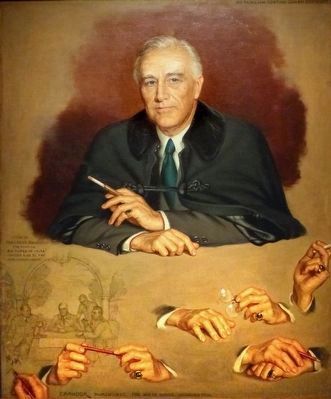
Photographed By Allen C. Browne, February 16, 2015
6. Franklin D. Roosevelt
This 1945 Portrait of Franklin D. Roosevelt by Douglas Chandor hangs in the National Portrait Gallery in Washington, DC.
“When Franklin Roosevelt began serving in New York's state legislature in 1911, some observers declared him ill-suited to the rough realities of politics. But Roosevelt thrived on those realities; some two decades later, he was advancing from the New York governorship to the presidency.
Taking office against the bleak backdrop of the Great Depression, Roosevelt responded quickly to this economic disaster with a host of regulatory and welfare measures that redefined the government's role in American life. Among conservatives, the new federal involvement in matters traditionally left to the private sector was a betrayal of America's ideals. But in other quarters, Roosevelt's activism inspired an unwavering popularity that led to his election to an unprecedented four terms.
When Roosevelt sat for this portrait in 1945, his presidential concerns had long since shifted to guiding the nation through World War II. This likeness is a study for a larger painting a sketch of which appears at the lower left commemorating Roosevelt's meeting with wartime Allied leaders, Winston Churchill and Joseph Stalin at Yalta.” — National Portrait Gallery
“When Franklin Roosevelt began serving in New York's state legislature in 1911, some observers declared him ill-suited to the rough realities of politics. But Roosevelt thrived on those realities; some two decades later, he was advancing from the New York governorship to the presidency.
Taking office against the bleak backdrop of the Great Depression, Roosevelt responded quickly to this economic disaster with a host of regulatory and welfare measures that redefined the government's role in American life. Among conservatives, the new federal involvement in matters traditionally left to the private sector was a betrayal of America's ideals. But in other quarters, Roosevelt's activism inspired an unwavering popularity that led to his election to an unprecedented four terms.
When Roosevelt sat for this portrait in 1945, his presidential concerns had long since shifted to guiding the nation through World War II. This likeness is a study for a larger painting a sketch of which appears at the lower left commemorating Roosevelt's meeting with wartime Allied leaders, Winston Churchill and Joseph Stalin at Yalta.” — National Portrait Gallery
Credits. This page was last revised on November 19, 2019. It was originally submitted on August 15, 2009, by Thomas Onions of Olathe, Kansas. This page has been viewed 1,758 times since then and 41 times this year. Photos: 1, 2. submitted on August 15, 2009, by Thomas Onions of Olathe, Kansas. 3, 4, 5. submitted on August 19, 2009. 6. submitted on November 2, 2015, by Allen C. Browne of Silver Spring, Maryland. • Syd Whittle was the editor who published this page.
